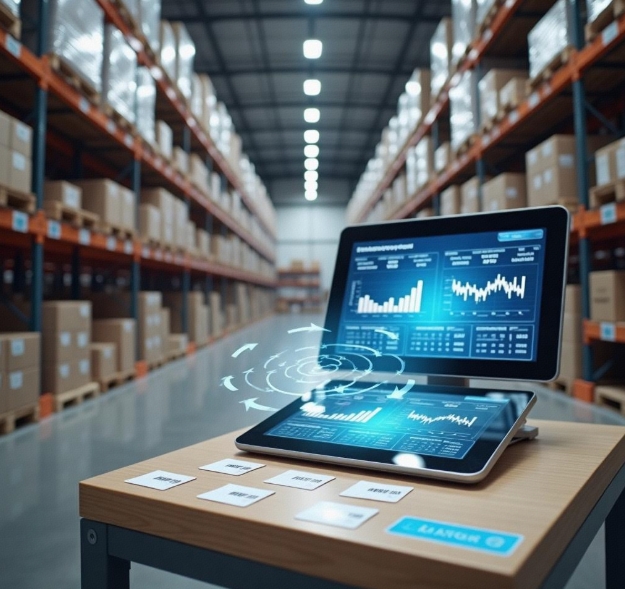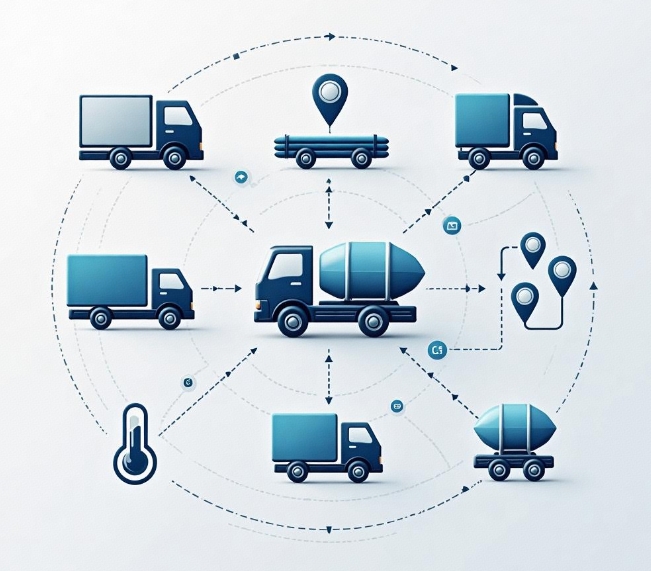How to Enhance Supply Chain Management Efficiency Through IoT Development
- latest articles
- 1.DApp Development & Customization: Merging Diverse Market Needs with User Experience 2.Analysis of the Core Technical System in DApp Project Development 3.How to achieve cross-chain interoperability in Web3 projects? 4.How does the tokenization of points reconstruct the e-commerce ecosystem? 5.How to Set and Track Data Metrics for a Points Mall? 6.What is DApp Development? Core Concepts and Technical Analysis 7.Inventory of commonly used Web3 development tools and usage tips 8.Development of a Distribution System Integrated with Social E-commerce 9.Six Key Steps for Businesses to Build a Points Mall System 10.What is DApp Development? A Comprehensive Guide from Concept to Implementation
- Popular Articles
- 1.Future Trends and Technology Predictions for APP Development in 2025 2.Analysis of the DeFi Ecosystem: How Developers Can Participate in Decentralized Finance Innovation 3.From Zero to One: How PI Mall Revolutionizes the Traditional E-commerce Model 4.DAPP Development | Best Practices for Professional Customization and Rapid Launch 5.How to Develop a Successful Douyin Mini Program: Technical Architecture and Best Practices 6.Recommended by the Web3 developer community: the most noteworthy forums and resources 7.From Cloud Computing to Computing Power Leasing: Building a Flexible and Scalable Computing Resource Platform 8.Shared Bike System APP: The Convenient Choice in the Era of Smart Travel 9.How to Create a Successful Dating App: From Needs Analysis to User Experience Design 10.From Design to Development: The Complete Process of Bringing an APP Idea to Life
With the development of globalization and digitalization, supply chain management (SCM) faces increasing challenges. Enterprises must not only respond to complex market demands and globalized procurement models but also consider how to improve operational efficiency, reduce costs, and enhance customer satisfaction. The rapid advancement of the Internet of Things (IoT) offers new opportunities for enhancing supply chain management. Through the application of IoT technology, companies can achieve real-time monitoring, intelligent scheduling, accurate forecasting, and dynamic adjustments, thereby effectively improving the efficiency of supply chain management.
This article will explore how IoT plays a role in supply chain management, analyze its applications across various stages, and provide practical examples to help businesses understand how to leverage IoT technology to enhance supply chain management efficiency.
The Relationship Between IoT and Supply Chain Management
The Internet of Things connects various devices, sensors, machines, and more in the physical world via the internet, enabling real-time exchange and sharing of information. Through IoT technology, devices and systems can automatically perceive and respond to changes in the external environment, making the entire system more intelligent and flexible.
In supply chain management, IoT can help companies achieve end-to-end monitoring of goods, transportation, inventory, and other aspects. Through embedded sensors and real-time data collection technologies, businesses can obtain more accurate supply chain information, reduce human errors, and enhance decision-making efficiency and precision.
1. Improving Inventory Management Efficiency
Inventory management is a critical component of supply chain management. Traditional inventory management relies on manual counts and periodic checks, which can lead to overstocking or shortages, exposing companies to risks of high inventory costs or failure to meet customer demands. IoT technology, through smart tags, RFID (Radio Frequency Identification), barcode scanning, and other technologies, enables real-time monitoring of inventory levels, reduces manual intervention, and improves the accuracy and efficiency of inventory management.
For example, many large retailers have implemented RFID tags on products to achieve real-time tracking and automatic updates of inventory information. This allows managers to monitor the inventory status of each product at any time, adjust replenishment plans promptly, and avoid stockouts or excess inventory. Additionally, IoT can integrate with enterprise ERP systems and supply chain management systems (SCM) to automate inventory replenishment and order processing, significantly enhancing the responsiveness of the supply chain.
2. Achieving Logistics Process Visibility
Logistics management is another major challenge in the supply chain, especially in globalized supply chains where long transportation routes and complex modes of transport make it difficult to track information such as transit times, locations, and statuses, affecting supply chain transparency and management efficiency. The application of IoT enables real-time monitoring of the transportation process, enhancing logistics transparency and visibility.
By installing GPS positioning devices, temperature and humidity sensors, vibration sensors, etc., on transport vehicles and goods, companies can obtain various types of data in real-time during transit. For instance, temperature and humidity sensors help monitor temperature changes in cold chain logistics, ensuring that food or pharmaceuticals remain within the specified temperature range during transport, thereby preventing quality issues.
Furthermore, through IoT technology, companies can dynamically adjust transportation routes and dispatch vehicles during transit, optimizing the allocation of transport resources, improving logistics efficiency, and reducing transportation costs. For example, e-commerce giants like Amazon and Alibaba have widely adopted IoT technology in their logistics centers and delivery processes, greatly enhancing logistics efficiency.
3. Enhancing Supply Chain Forecasting Capability
A major challenge in supply chain management is accurately forecasting demand. Traditional demand forecasting often relies on historical data and market trends, but these methods are susceptible to external environmental changes and struggle to achieve precision. The application of IoT technology can improve the accuracy of demand forecasting through real-time data collection and analysis.
For example, IoT can help companies collect consumer behavior data, including online browsing, purchasing habits, and social media interactions, combined with sensor and RFID technology to gather inventory and logistics data, thereby providing more accurate demand forecasts. This data can assist businesses in better planning production schedules, inventory management, and distribution arrangements, avoiding economic losses due to under-supply or oversupply.
Additionally, real-time data acquisition through IoT can help companies identify potential issues in the supply chain. For instance, sensors can detect early signs of machine equipment failure, prompting companies to perform maintenance or replacements in advance, thus preventing production halts or transportation delays.
4. Optimizing Supply Chain Collaboration
Supply chain management involves multiple stages and partners, from raw material suppliers and manufacturers to distributors and retailers, making efficient collaboration throughout the process crucial. The application of IoT enables real-time information sharing and automated coordination across all stages, reducing information silos and communication costs.
Through IoT technology, companies can establish a unified information platform across the entire supply chain, allowing all parties to share data on orders, inventory, transportation, etc. Suppliers, producers, and distributors can view order and inventory statuses in real-time, adjusting production plans, procurement plans, and distribution arrangements based on real-time information, achieving efficient supply chain collaboration.
For example, some manufacturing companies use IoT technology to interface with suppliers and logistics companies, enabling automatic order placement, real-time inventory updates, and dynamic adjustments to transportation routes, greatly enhancing the supply chain's responsiveness and collaboration efficiency.
5. Strengthening Supply Chain Risk Management
Supply chain management must not only focus on efficiency improvements but also consider how to mitigate risks. IoT technology can help companies increase supply chain transparency, promptly identify potential risks, and take countermeasures. By monitoring all stages of the supply chain in real-time, businesses can detect bottlenecks, anomalies, or risk points early, thereby avoiding the occurrence of unexpected events.
For instance, IoT can help companies monitor factors such as weather changes and traffic conditions during transportation, predicting possible delays or safety issues and allowing for preemptive measures. Additionally, IoT technology can assist in tracking suppliers' production and delivery statuses, ensuring timely supply of raw materials and reducing losses caused by supply chain disruptions or delays.
Application Cases of IoT in Supply Chain Management
1. HP's Smart Inventory Management
HP has implemented smart inventory management across its global supply chain using IoT technology. By installing RFID tags and sensors in its major warehouses and retail stores worldwide, HP tracks inventory in real-time. Through the integration of RFID and IoT platforms, HP can accurately grasp the inventory data of each product, adjust replenishment plans promptly, and avoid overstocking or stockouts. HP also utilizes IoT technology to automate warehouse management, improving operational efficiency and reducing manual intervention and inventory errors.
2. Walmart's Logistics Optimization
Walmart, one of the world's largest retailers, has also adopted IoT technology early in its logistics management system. By equipping transport vehicles with GPS positioning devices and sensors, Walmart monitors the status and location of goods in real-time. The application of IoT technology enables Walmart to optimize transportation routes, reducing transit times and costs. Additionally, Walmart uses IoT systems to monitor inventory and orders in real-time, automatically adjusting replenishment plans and delivery schedules, significantly enhancing supply chain efficiency.
Conclusion
IoT technology has brought significant transformations to supply chain management, helping companies improve efficiency in inventory management, logistics visibility, demand forecasting, supply chain collaboration, and risk management. Through real-time data collection and analysis, businesses can make more accurate decisions, optimize resource allocation, and enhance the responsiveness and flexibility of the supply chain.
However, despite the immense potential of IoT technology in enhancing supply chain management efficiency, its implementation still faces challenges, including device and system compatibility, data security, and privacy protection. Companies need to gradually advance the application of IoT technology based on their specific circumstances to ensure smooth deployment and operation.
As IoT technology continues to develop and become more widespread, future supply chain management will become increasingly intelligent and digital. For businesses, taking the lead in adopting IoT technology will provide a competitive edge in the fierce market competition.
-

How to Use IoT Development to Enhance Supply Chain Efficiency
With the rapid development of the global economy and the deepening of digital tr···
-

Development and Innovation of the Internet of Things in the Healthcare Sector
With the rapid advancement of information technology, the Internet of Things (Io···
-

Data Storage and Analysis Methods in IoT Development
The Internet of Things (IoT) is one of the most revolutionary innovations in tod···

 Blockchain
Blockchain












